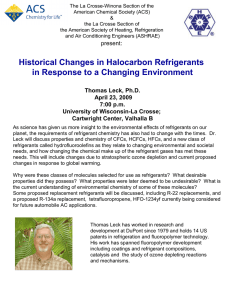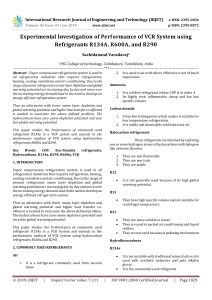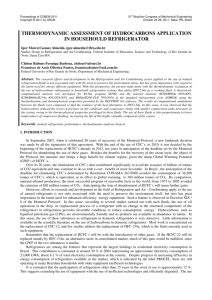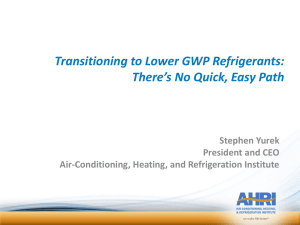Global Journal of Advance Engineering Technologies and Sciences
advertisement
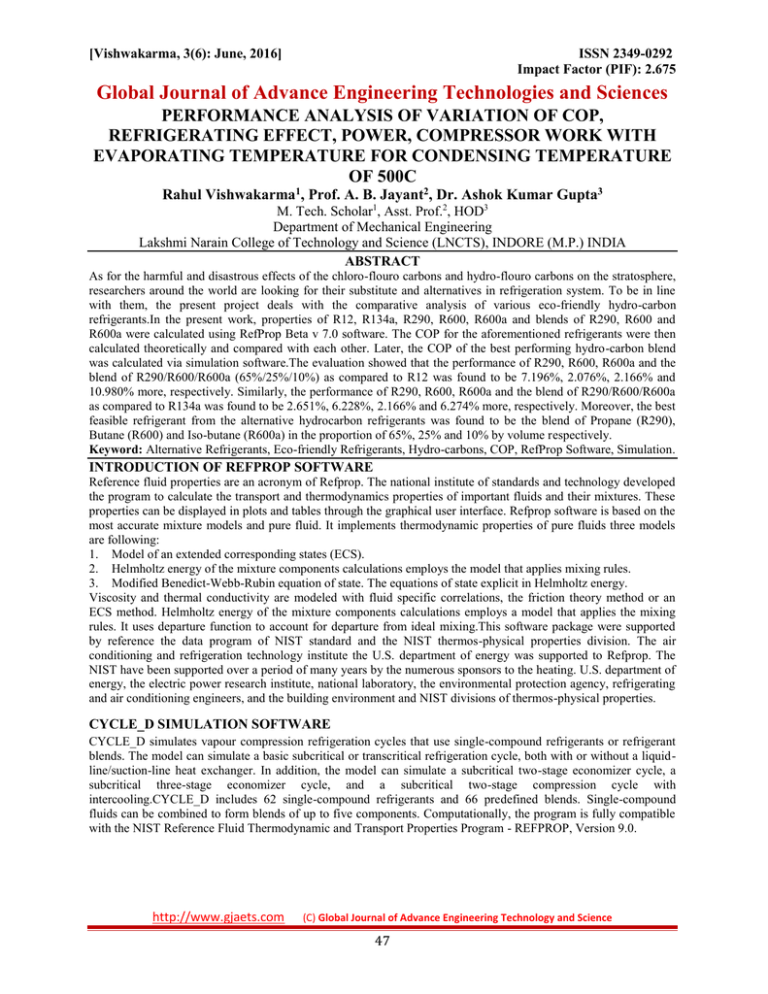
[Vishwakarma, 3(6): June, 2016] ISSN 2349-0292 Impact Factor (PIF): 2.675 Global Journal of Advance Engineering Technologies and Sciences PERFORMANCE ANALYSIS OF VARIATION OF COP, REFRIGERATING EFFECT, POWER, COMPRESSOR WORK WITH EVAPORATING TEMPERATURE FOR CONDENSING TEMPERATURE OF 500C Rahul Vishwakarma1, Prof. A. B. Jayant2, Dr. Ashok Kumar Gupta3 M. Tech. Scholar1, Asst. Prof.2, HOD3 Department of Mechanical Engineering Lakshmi Narain College of Technology and Science (LNCTS), INDORE (M.P.) INDIA ABSTRACT As for the harmful and disastrous effects of the chloro-flouro carbons and hydro-flouro carbons on the stratosphere, researchers around the world are looking for their substitute and alternatives in refrigeration system. To be in line with them, the present project deals with the comparative analysis of various eco-friendly hydro-carbon refrigerants.In the present work, properties of R12, R134a, R290, R600, R600a and blends of R290, R600 and R600a were calculated using RefProp Beta v 7.0 software. The COP for the aforementioned refrigerants were then calculated theoretically and compared with each other. Later, the COP of the best performing hydro-carbon blend was calculated via simulation software.The evaluation showed that the performance of R290, R600, R600a and the blend of R290/R600/R600a (65%/25%/10%) as compared to R12 was found to be 7.196%, 2.076%, 2.166% and 10.980% more, respectively. Similarly, the performance of R290, R600, R600a and the blend of R290/R600/R600a as compared to R134a was found to be 2.651%, 6.228%, 2.166% and 6.274% more, respectively. Moreover, the best feasible refrigerant from the alternative hydrocarbon refrigerants was found to be the blend of Propane (R290), Butane (R600) and Iso-butane (R600a) in the proportion of 65%, 25% and 10% by volume respectively. Keyword: Alternative Refrigerants, Eco-friendly Refrigerants, Hydro-carbons, COP, RefProp Software, Simulation. INTRODUCTION OF REFPROP SOFTWARE Reference fluid properties are an acronym of Refprop. The national institute of standards and technology developed the program to calculate the transport and thermodynamics properties of important fluids and their mixtures. These properties can be displayed in plots and tables through the graphical user interface. Refprop software is based on the most accurate mixture models and pure fluid. It implements thermodynamic properties of pure fluids three models are following: 1. Model of an extended corresponding states (ECS). 2. Helmholtz energy of the mixture components calculations employs the model that applies mixing rules. 3. Modified Benedict-Webb-Rubin equation of state. The equations of state explicit in Helmholtz energy. Viscosity and thermal conductivity are modeled with fluid specific correlations, the friction theory method or an ECS method. Helmholtz energy of the mixture components calculations employs a model that applies the mixing rules. It uses departure function to account for departure from ideal mixing.This software package were supported by reference the data program of NIST standard and the NIST thermos-physical properties division. The air conditioning and refrigeration technology institute the U.S. department of energy was supported to Refprop. The NIST have been supported over a period of many years by the numerous sponsors to the heating. U.S. department of energy, the electric power research institute, national laboratory, the environmental protection agency, refrigerating and air conditioning engineers, and the building environment and NIST divisions of thermos-physical properties. CYCLE_D SIMULATION SOFTWARE CYCLE_D simulates vapour compression refrigeration cycles that use single-compound refrigerants or refrigerant blends. The model can simulate a basic subcritical or transcritical refrigeration cycle, both with or without a liquidline/suction-line heat exchanger. In addition, the model can simulate a subcritical two-stage economizer cycle, a subcritical three-stage economizer cycle, and a subcritical two-stage compression cycle with intercooling.CYCLE_D includes 62 single-compound refrigerants and 66 predefined blends. Single-compound fluids can be combined to form blends of up to five components. Computationally, the program is fully compatible with the NIST Reference Fluid Thermodynamic and Transport Properties Program - REFPROP, Version 9.0. http://www.gjaets.com (C) Global Journal of Advance Engineering Technology and Science 47 [Vishwakarma, 3(6): June, 2016] ISSN 2349-0292 Impact Factor (PIF): 2.675 Fig.1 Cycle D Simulation Software The basic subcritical or trans-critical system simulated by CYCLE_D consists of a compressor, a discharge line, a condenser for the subcritical cycle (a gas cooler for the trans-critical cycle), an expansion device, an evaporator, a compressor suction line, and an optional liquid-line/suction-line heat exchanger. The other subcritical cycles may contain a second compressor, and one or two economizers or an intercooler (but do not include the liquidline/suction-line heat exchanger).The user of the program has to specify the refrigerant and provide input data for the above hardware components, except the expansion device, which is modeled as being isenthalpic. The user can also specify the power requirements of the indoor fan, outdoor fan, and control unit of the system. A. Simple Vapour Compression Refrigeration System shows the figure 2 systematic diagram of a simple vapour compression refrigeration system. Fig. 2 Simple Vapour Compression Refrigeration System http://www.gjaets.com (C) Global Journal of Advance Engineering Technology and Science 48 [Vishwakarma, 3(6): June, 2016] ISSN 2349-0292 Impact Factor (PIF): 2.675 RESULTS AND DISCUSSION In this chapter, result and discussion for the data obtained through NIST’s REFPROP 7.0 beta software, Cycle_D software and manual evaluation is carried out.Performance of Hydrocarbon Refrigerant. Refrigerating Effect, KJ/Kg 300 250 200 R-12 150 R-134a 100 R290/R600/R 600a 50 0 oc Evaporating 5 -5Temperature, -10 -15 Fig. 3 Variation of refrigerating effect with evaporating temperature for condensing temperature of 50 0c 6 COP 5 4 R-12 3 R-134a 2 R290/R600/R 600a 1 0 5 Evaporating Temperature, oc -5 -10 -15 Fig. 4 Variation of COP with evaporating temperature for condensing temperature of 50 0c http://www.gjaets.com (C) Global Journal of Advance Engineering Technology and Science 49 [Vishwakarma, 3(6): June, 2016] ISSN 2349-0292 Impact Factor (PIF): 2.675 Compressor Work Done, KJ/Kg 100 90 80 70 R-12 60 50 R-134a 40 R290/R600/R6 00a 30 20 10 0 5 -5 -10 Evaporating Temperature,oc -15 Fig. 5 Variation of compressor work done with evaporating temperature for condensing temperature of 50 0c 1.6 1.4 Power, KW 1.2 R-12 1 0.8 R-134a 0.6 R290/R600/R60 0a 0.4 0.2 0 5 oc -5 -10 Evaporating Temperature, -15 Fig. 6 Variation of power with evaporating temperature for condensing temperature of 50 0c On theoretical evaluation, the performance of R290, R600, R600a and the blend of R290/R600/R600a (65%/25%/10%) as compared to R12 (Chloro-flouro Carbon) was found to be 7.196%, 2.076%, 2.166% and 10.980% more, respectively. Similarly, the performance of R290, R600, R600a and the blend of R290/R600/R600a as compared to R134a (Hydro-flouro carbon) was found to be 2.651%, 6.228%, 2.166% and 6.274% more, respectively. However, the performance of the blend (R290/R600/R600a) as calculated through simulation using cycle_D software was found to be 2.54. REFERENCES 1. 2. A. Baskaran, P. Koshy Mathews, 2012. A performance Compression of Vapour Compression Refrigeration System Using Eco Friendly Refrigerants of Low Global Warming Potential. International Journal of Scientific and Research Publications. Volume 2. Issue 9, September. Ahmad Selim DALKILIC, 2012. Theoretical analysis on the prediction of performance coefficient of twostage cascade refrigeration system using various alternative refrigerants. Journal of Thermal Science and Technology, pp67-79. http://www.gjaets.com (C) Global Journal of Advance Engineering Technology and Science 50 [Vishwakarma, 3(6): June, 2016] 3. 4. 5. 6. 7. 8. 9. 10. 11. 12. 13. 14. 15. 16. 17. 18. 19. 20. ISSN 2349-0292 Impact Factor (PIF): 2.675 Amjad Khan, Dr. KuldeepOjha and PrakashGawali, 2013. Analysis of Modern Eco-Friendly Refrigerant. International Journal on Emerging Technologies, pp177-181. Arora C.P., 2013. Refrigeration and Air Conditioning, McGraw Hill Publishers, New Delhi, pp128-208. B.O. Bolaji, m.a.akintunde, and t.o. falade, 2011. Comparative analysis of performance of three ozonefriends HFC Refrigerants in a vapour compression refrigerator. Journal of sustainable Energy & Environment. Vol.2, pp61-64. Bukola O. Bolaji and ZhongieHuan, 2013. Thermodynamic analysis of hydro-carbon refrigerants in a subcooling refrigeration system. Journal of Engineering. Vol 1- (1) pp317-333. Jacqueline BianconCopetti, Mario Henrique Macagnan, Mariana Geyer, Rejane De CesaroOliveski, 2005. The Use of Hydrocarbons Propane and Isobutane in Refrigeration Systems. 18th International Congress of Mechanical Engineering. November 6-11 Khurmi R.S. and Gupta J. K., 1998. Refrigeration and Air Conditioning, Eurasia Publishers, New Delhi, pp248-266. M. Ashok Chakravarthy, M. L. S. Deva Kumar, 2012. Experimental Investigation of an Alternative Refrigerant for R22 in Window Air Conditioning System. International Journal of Scientific and Research Publications. Volume 2, Issue 10. October Mohamed M. EI-Awad, 2009. A computerized analytical model for evaluating hydrocarbon fluids as natural alternative refrigerants. World Journal of Modelling and Simulation. Vol.5 No. 3. Pp232-240. Mohd. AasimNazeer Ahmad Quraishi, u.s.wankhede, 2013. Use of hydrocarbons and other blends as refrigerant. international Journal of Modern Engineering Research.vol.3.Issue 1, pp250-253. Mohd. AasimNazeer Ahmad, chidanandmangrulkar, ehsanullah khan, syedmohiuddin, 2014. Experimental analysis of refrigerator by replacing conventional HFC refrigerants with hydrocarbons. IOSR Journal of Mechanical and Civil Engineering, pp01-05. N. Austin, P. Senthikumar and S. Purushothaman, 2012. Mixed refrigerants suitability analysis using artificial neutral networks. ARPN Journal of Engineering and Applied Sciences. Vol. 7, No. 5, May. Rafael Quintero Ricardo, 2007. Analysis of the behavior of ternary hydrocarbon mixture as substitutes of the CFC-12. International Conference on Energy and Environment. May 15-17. Rajnikant Y. Mahajan, Sanjay Kumar A. Borikar, 2014. Performance Evaluation of Domestic Refrigerator Using Hc-12a Refrigerant as an Alternative Refrigerant to R12 and R134a. The International Journal of Engineering and Science. Volume 3, pp26-37. S. Chen, J. F. Judge, E. A. Groll and R. Radermacher, 1994. Theoretical Analysis of Hydrocarbon Refrigerant Mixtures as a Replacement for HCFC-22 for Residential Uses. International Refrigeration and Air Conditioning Conference, pp252. Safvan Khan Sahib, Dr. R. G. Kapadia, 2015. A Review on Domestic Refrigerator Using Hydrocarbons as Alternative Refrigerants to R134a. International Journal of Innovative Research in Science, Engineering and Technology. Vol. 4, Issue 6 May. Sandip P. Chavhan, Prof. S. D. Mahajan, 2013. A Review of an Alternative to R134a Refrigerant in Domestic Refrigerator. International Journal of Emerging Technology and Advanced Engineering. Volume 3, Issue 9, September. SomchaiWongwises, Nares Chimres, 2005. Experimental study of hydrocarbon mixtures to replace HFC134a in a domestic refrigerator. Energy Conversion and Management. Vol.46.pp85-100 Zainalzakaria, and Zulaikhashahrum, 2011. The possibility of using liquefied petroleum gas in domestic refrigeration systems. IJRRAS. Vol 9. http://www.gjaets.com (C) Global Journal of Advance Engineering Technology and Science 51

